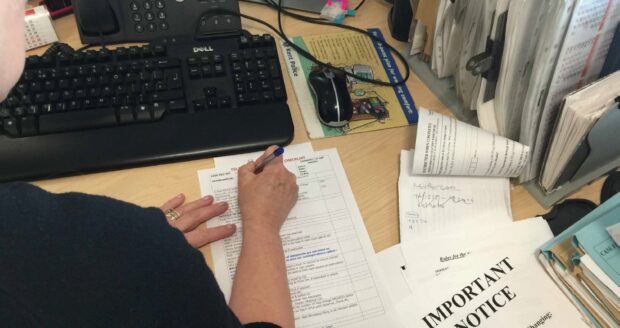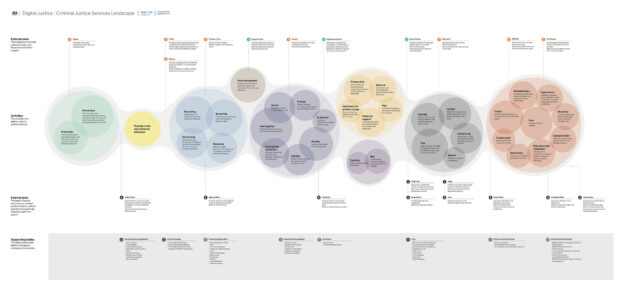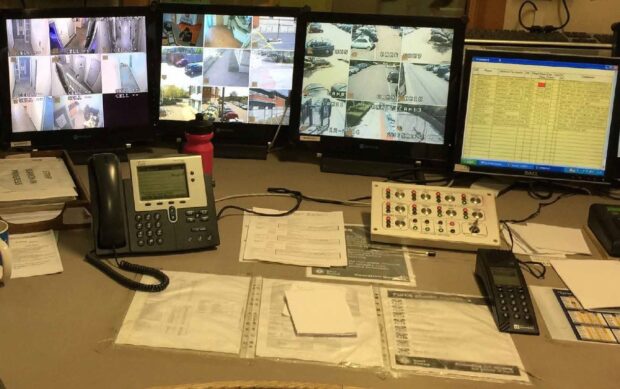How we’re making it easier to share data across the criminal justice system.
Joining up fragmented systems
Data is at the heart of the criminal justice system. Information is captured at different points by a variety of agencies who use it to help make important and informed decisions. For instance, the information might be used to decide whether to charge or detain someone accused of a crime.
But there’s a problem.
At the moment, all this important data is held in large, disparate systems owned by different agencies – such as police forces, prosecutors, courts, prisons and probation services. This makes it hard to share, and means staff may not have all the information when they need it.
These systems are expensive to maintain, hard to upgrade and more and more out of step with what users need and expect. Staff often have to manually re-enter data or phone up colleagues in other organisations to get important information.

Mapping the data landscape
Earlier this year we tracked how data is managed across the system, in a criminal justice services landscape map. This showed how the system was experienced by its users and the different steps they go through as a case is passed between different agencies.

Since then, we’ve been looking in more detail at the flow of data within the system. You can see where agencies swap info in the data exchange landscape map.
As you can see below, it’s a tangled web – with numerous contact points, criss-crossing lines and a lot of overlap.

The diagram shows the sheer amount of duplication in the system, and helps us to plan how best to change things.
Opening up access
Over the coming months, we’ll be looking to build simple tools and programs (known as Application Programming Interfaces or APIs) that will open up the data held in the separate systems.
We’ll also be teaming up with the Government Digital Service, who are doing related work on data and registers. Pooling knowledge will help us identify the best opportunities and which datasets we can streamline.

Setting guiding principles
We’re investing time to set the principles for this work, to make sure that data sharing is built-in, not just an expensive or optional extra.
It’s a complex area that we’ll be exploring in future blog posts but some initial proposals are already taking shape:
- agencies which collect data must ensure other business areas can access the information
- there should be clearer ownership of data so people know who to ask for access
- we should improve access to data by sharing it from one definitive place, rather than passing it back and forth between multiple systems
The time is right for change
Opening up access to data and making it more available is not a new idea, but we now have the technology and digital skills to make this possible.
We’ve listened to users and want them to have a radically better and easier experience – and one that delivers better results.
Let us know what you think
Do you have problems accessing or using information in the criminal justice system? What do you think the main problems are, and do you have any ideas for how we can improve things?
Please let us know: we’d love to know what you think. You can comment below or email us at contact-us@digital.justice.gov.uk.
Don't miss out on future blog posts: sign up for email alerts.

7 comments
Comment by Mike D posted on
Thanks, this is an interesting blog. As an industry supplier who has been watching the CJS story unfold over the last few years can I raise a few points to get your view on how the API approach you’ve outlined above is going to really deliver some transformational change in the CJS.
One thing your blog doesn’t mention is the number of times data integration and standards has been tried before in the CJS. Back in 2003, there was a £1 Billion investment in joining up the Criminal Justice System. The concept at the time was a “Virtually Unified Case File” which would join up all case management systems across the CJS. This proved too complex so this then morphed into the CJS Exchange (which is still going), as a means to use common data standards to transfer data between systems. It never lived up to its promise and quickly got marginalised to do point-to-point data sharing of systems like Libra (HMCTS) and COMPASS (CPS).
Around 2007, the emphasis moved to considering all CJS data as a “semantic web” which aimed to take the latest silicon valley technology thinking to again focus on common data formats and exchange protocols on the web. I don’t think this got off the ground. In the last couple of years we’ve seen the HMCTS Common Platform touted as a potential candidate for cross-CJS data integration (trying to pull together all the NOMIS/COMPASS/Libra systems that are still out there)..
The MOJ Digital Strategy published in 2012 (now over 3 years ago!) said “[we will]..default to open standards and making greater use of APIs in the development of our services”. So MOJ has been talking about building API’s since then but what has really happened in the last 3 years? We’ve had some simple web services built but no heavy duty technology transformation to really capitalise on the potential that integrating the CJS could bring. Also, as well as the technology, surely one of the things that continues to hamper the CJS is the siloed nature of the key players (MOJ, CPS, NOMS, HMCTS) and the politics that goes with that.
I genuinely welcome new developments in this space, but I worry that we’re about to go through another fad in a very long journey which will be replaced by the latest technology flavour in a years time without delivering anything of consequence. So I guess my question is: “what do you really think will be different this time?”.
Thanks and would love to hear your view.
Comment by Graham Lee posted on
Hi Mike,
I asked Kit about this, and she replied as follows:
Mike, thanks very much for your question. Indeed there have been many attempts at technology-driven reform in the justice system, and as you say many of these have not been capitalised on to their fullest.
In answer to your question, 'why will this time be different?', there are a few interlinked answers:
- Firstly, we've now got substantial digital teams in every major agency in the justice system. This means that for the first time, we're in a position to move away from paying external suppliers to drive our approach to new ways of working, to taking responsibility for tackling these ideas head on ourselves. As well as providing better value for money, it means we can pool our knowledge between agencies quickly and cheaply, and find the best way forward for government, users and the taxpayer.
- Secondly, the use of cloud technology within government for the first time (hosting and services) allows APIs to be useful – in the past any attempts to capitalise on an API was extremely difficult and costly because of the effort needed to breach agency boundaries (network and security).
- Thirdly, we've got a specific programme of work to look just at API/integration work where this has currently been tackled transactional service by transactional service. This programme of work is agnostic to agency boundaries, meaning that the siloed approach to technology transformation that you reference will begin to be rectified by the common approach we're taking. The programme also includes establishing data principles at a pan-justice level; this is different to simply 'setting standards', as it will address the underlying reasons why standards-alignment happens or doesn't happen by tackling division of responsibilities, and making data responsibilities clearer.
- And lastly, this data work will be governed by a group on which the whole justice system is represented. As before, this will help to tackle siloed working and will mean that every part of the justice system is given equal voice in taking forward new standards and ways of working.
We can always do more - we can always wish we'd done more in the past - but this truly is a large and different step forward.
Comment by Mike D posted on
Hi Graham, Kit
Thank you for your reply and I appreciate your frankness.
I really hope that the digital teams that are being built in each agency will be able to address these quite challenging issues. I understand the governments desire to move away from suppliers – but we shouldn’t demonise them too much, they are (hopefully/usually/sometimes!) experts in what they do. I imagine government has a major challenge in building up the internal capability levels of civil servants to compete with software and technology firms that do this day in and day out. Yes, I imagine that cloud technologies will help, although with a long lead time to get core CJS systems all moved to the cloud. The API/integration work and cross-CJS working also sounds encouraging.
What would be really good would be regular blog updates to hear how things are progressing.
Thanks again for your response – best wishes for Christmas and look forward to hearing all about progress next year!
Mike
Comment by Graham Lee posted on
Hi Mike,
Thanks again for your comments. We'll be sure to keep you posted. Best wishes for the new year!
Kind regards,
Graham
Comment by Mike D posted on
Hi Graham, Kit
How's the progress on API development in the CJS going, is the data getting opened up and do you feel you're making progress? Are there any new services out there now? Would be good to have an update.
Thanks
Mike
Comment by Graham Lee posted on
Hi Mike,
I asked colleagues for an update on this –
We have had some success in highlighting the value of open data through events like our hackathon and many parts of the department are building APIs for data. However, as opening up data publicly wasn't in the original business cases, we're struggling to encourage programmes and project teams to prioritise making the APIs open (where the data can be opened up).
We'll post updates on the blog on new services and progress on the APIs.
I hope that helps for now.
Thanks,
Graham
Comment by Robyn posted on
Hi Graham,
I would be interested in knowing where this is now? Can you provide a further update?
Robyn